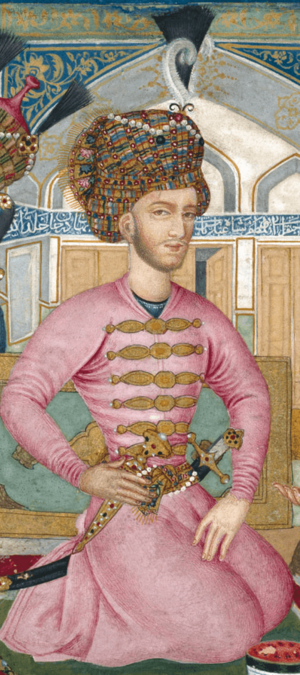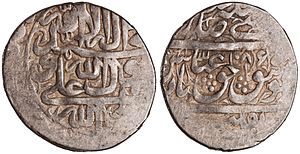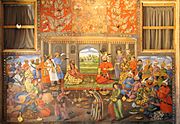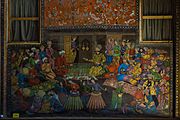Abbas II of Persia facts for kids
Quick facts for kids Abbas II |
|
|---|---|

Shah Abbas II in 1663
|
|
| Shah of Iran | |
| Reign | 15 May 1642 – 26 October 1666 |
| Coronation | 15 May 1642 in Kashan |
| Predecessor | Safi I |
| Successor | Suleiman I |
| Born | Soltan Mohammad Mirza 30 August 1632 Qazvin, Iran |
| Died | 26 October 1666 (aged 34) Behshahr, Iran |
| Burial | Fatima Masumeh Shrine, Qom, Iran |
| Spouse |
|
| Issue |
|
| House | Safavid dynasty |
| Father | Safi I |
| Mother | Anna Khanum |
| Religion | Twelver Shia Islam |
| Tughra |  |
Abbas II (Persian: عباس دوم, romanized: ʿAbbās II), born Soltan Mohammad Mirza, was a powerful ruler of Iran. He was the seventh Shah (king) of the Safavid Empire. He ruled from 1642 to 1666.
Abbas II became king when he was only nine years old. His father was Safi I. Because he was so young, a trusted advisor named Saru Taqi helped him rule. During this time, Abbas received special training to become a king. By age fifteen, he took full control of his government. He became an absolute ruler. His time as king was mostly peaceful and saw good progress for Iran.
Contents
Early Life and Becoming King
Soltan Mohammad Mirza was born on August 30, 1632, in Qazvin, Iran. He was the oldest son of Shah Safi I and his mother, Anna Khanum. He grew up in the royal palace, surrounded by women and eunuchs. He had a teacher named Rajab Ali Tabrizi.
His mother, Anna Khanum, became important in the palace because she had given birth to the future king. Saru Taqi, the grand vizier (chief minister), had a close relationship with Anna Khanum. She helped him rule Iran when Mohammad Mirza became king.
His father, Safi, wanted to blind Mohammad Mirza and his brothers. This was to prevent them from trying to take the throne. But a kind eunuch helped Mohammad Mirza pretend to be blind. This way, he kept his eyesight until his father died. Because of this trick, he was still learning to read and write at age ten.
On May 15, 1642, when he was nine and a half, Mohammad Mirza became king. This happened four days after his father, Safi, died. At his coronation, Mohammad Mirza chose the name Abbas II. He also reduced taxes and banned alcohol. Saru Taqi stayed in his powerful role. He removed rivals to keep his power strong.
Abbas, who had been kept away from the outside world, was sent to Qazvin for more education. He learned quickly and became interested in theology (the study of religion). He also learned how to ride horses, do archery, and play polo.
Taking Control of the Government
For the first few years of his rule, Saru Taqi and other powerful officials truly ran Iran. However, Saru Taqi was assassinated on October 11, 1645. One of the conspirators, Jani Khan, had convinced Abbas that Saru Taqi was harming the country. Abbas gave the order for Saru Taqi's death.
This event gave Abbas the confidence to take full control. That same year, he removed many officials from their positions. This was a very bloody time. Between 8,000 and 10,000 people were killed. Jani Khan was also poisoned by the royal sommelier (wine steward). Abbas's mother, Anna Khanum, was sad about Saru Taqi's death. She ordered the punishment of Jani Khan's tribe.
Abbas then chose Khalifeh Soltan to be his new grand vizier. Khalifeh Soltan had served as grand vizier before. He was the first religious leader to hold this position. He wanted to make sure religious laws were followed.
When Saru Taqi died and Khalifeh Soltan was appointed, Abbas began his absolute rule. He was fifteen years old and much more involved in government than his father had been. He took control of Saru Taqi's family lands for himself. He also added other cities like Hamadan and Kerman to the royal lands. This helped him centralize his power.
Abbas II's Reign
The War for Kandahar
Abbas II's reign was mostly peaceful. He avoided war with the Ottoman Empire. He also had good relations with the Uzbeks in the east. However, he did fight a war with the Mughal Empire from 1649 to 1653. The goal was to get back the city of Kandahar.
Kandahar had been given to the Mughal emperor, Shah Jahan, in 1638. Abbas's father had wanted to take it back but died before he could. In 1647, Abbas agreed not to attack Kandahar while Shah Jahan was fighting in another region.
In 1648, Shah Jahan failed to conquer Samarkand. Seeing this, Abbas decided to attack Kandahar. He led an army of 50,000 men. They reached Kandahar in January 1649. After two months of fighting, they took control of the city. The Iranian army faced many challenges during the siege. They were tired and not paid well. But they still won because the Mughals were weak at that time.
The Mughals tried to take Kandahar back. Prince Aurangzeb led the first attack, but it failed. Two years later, Shah Jahan himself tried with a large army. He had war elephants and cannons. But after four months, he had to retreat because of the cold weather. The last Mughal attempt was in 1653. Prince Dara Shikoh led this army. Abbas prepared his forces, even though he faced money problems. The Mughal army struggled and failed again. Kandahar stayed under Iranian control until 1709.
Conflicts in the North
In Georgia, a conflict happened between Teimuraz I and Rostom of Kartli. Teimuraz I was against Safavid rule. In 1633, Rostom Khan became King of Kartli with Safi's support. Rostom invaded Teimuraz's lands. Teimuraz continued to cause trouble until 1648. Then, at Abbas's request, Rostom invaded Kakheti and sent Teimuraz away.
In 1659, Rostom died. Abbas wanted to settle some tribes in Georgia. This caused a big rebellion called the Bakhtrioni uprising. Rebels attacked Iranian forts and drove out the tribes. Abbas decided not to settle the tribes there. He recognized Vakhtang V as the new King of Kartli. But he had the rebel leaders executed. To make peace, Abbas later married Vakhtang's daughter, Anuka.
During Abbas's reign, Iran's influence in the Caucasus region met with Russian interests. Russia started to make it harder for foreign merchants to trade silk through Iran. This led to a small conflict between 1651 and 1653. The Russians tried to expand their land south of the Terek river, which Iran considered its territory. They tried to build a fort for Teimuraz, the deposed Georgian king.
When Abbas heard this, he sent his army. Forces from Ardabil and other areas attacked the fort. They drove out the Russians and destroyed their base. After this, Iran and Russia continued talks for ten years to resolve their issues.
Financial Challenges
Khalifeh Soltan, the grand vizier, had a rival named Allahverdi Khan. Allahverdi was a childhood friend of Abbas and rose quickly in the government. By the early 1650s, he was Abbas's favorite. When Khalifeh Soltan died in 1654, Allahverdi helped Abbas appoint Mohammad Beg as the new grand vizier. Mohammad Beg was of Armenian origin.
Mohammad Beg's time in office saw a decline in the economy. This was mainly due to Abbas's expensive war in Kandahar and a lack of raw materials for silk trade. Mohammad Beg, despite his experience, could not fix the financial problems. He made things worse by increasing central control. He also cut military positions and tried to sell royal mansions, but no one bought them. He even banned gold coins, which flooded the country with silver coins.
Mohammad Beg also tried to find precious metals near Isfahan. He hired a French man who turned out to be a fraud. He also opened coal mines, which failed. These failures, along with his favoritism towards his family, made him unpopular. However, he kept his power and even gained control over many state affairs.
Abbas started spending more time in the palace or on hunting trips. Mohammad Beg hid bad news from him. Eventually, Allahverdi Khan told Abbas about Mohammad Beg's lies. Abbas then sent Mohammad Beg away to Qom in 1661. The Dutch East India Company was sad to see Mohammad Beg go. They had bribed him to secretly export gold through Iran.
Death of Abbas II
In 1661, Abbas appointed Mirza Mohammad Karaki as his last grand vizier. Karaki was a religious minister before this. He was described as slow and not very active. He was also a puppet of a group in the court. During his time, trade routes to the Levant (eastern Mediterranean) were promoted. He tried to fix the money problems Mohammad Beg had left behind.
However, Karaki had less influence over Abbas than previous viziers. Abbas spent more time in the palace and kept Karaki unaware of many things. Karaki did not even know that Abbas had a son named Sam Mirza.
In the last ten years of his reign, Abbas pulled back from state affairs. He held many lavish parties. After these parties, he would hide from the public for weeks. Finally, on October 26, 1666, Abbas II died in his winter town, Behshahr. He was 34 years old. He died from various illnesses. He was buried in Qom. His oldest son, Sam Mirza, became the next king. Abbas had two sons. He reportedly preferred his younger son, Hamza Mirza.
Policies of Abbas II
Religion and Tolerance
Abbas II's rule showed different approaches to non-Shi'a Muslims. He had Shi'a religious texts translated into Persian. He also asked religious scholars for advice on taxes. He was friends with famous Shi'a scholars of his time.
However, he was not an overly strict Shi'a Muslim. He respected his family's Sufi order, the Safaviyya. He built lodges in their holy city, Ardabil. He also talked with Sufi leaders. But the persecution of Sufis increased during his reign. Shi'a scholars wrote more against Sufis.
Despite his personal beliefs, Abbas continued to encourage religious conversion. Between 1645 and 1654, Safavid officials forced Iranian Jews to convert to Islam. They also made Armenian Christians move to New Julfa. One historian says 20,000 Jewish families converted. Another Armenian historian says the number was 350.
During Mohammad Beg's time, some Christian churches were closed. Christians were not allowed to build new ones. But Abbas himself was tolerant towards Christians. He often went to Armenian church services. He allowed Jesuits to start a mission in Isfahan in 1653. He even removed a senior Shi'a cleric for speaking against Christians. Three years after Mohammad Beg was dismissed, the Vank Cathedral and five other churches were finished.
Military Strength
Under Abbas II, the Safavid army began to decline. This was partly because of peace with the Ottoman Empire. It was also due to the money problems. The royal army did get a small group of 600 infantry soldiers in 1654, which later grew to 2,000.
However, the government could not afford to pay the army and also support the king's luxurious lifestyle. So, soldiers became poor. The strength of military units decreased. People said the Safavid army was good for parades but not for war.
International Relations
Abbas II's foreign policy was careful and smart. He supported European trading companies like the Dutch East India Company (VOC) and the East India Company. These companies bought silk from Iran. In return, they brought spices, sugar, and textiles.
Sometimes, these companies caused problems. In 1645, the VOC blocked the port of Bandar Abbas because of disagreements over silk trade. The blockade did not last long. The Dutch gave in to Iranian demands and signed a new silk treaty in 1652. The French East India Company also tried to trade with Iran. Abbas approved this shortly before he died, but nothing came of it at the time.
Peaceful relations with the Ottoman Empire continued. Abbas was not tempted to expand his territory. The Ottoman Sultan, Mehmed IV, was busy with other wars and internal problems. In 1657, a new trade agreement was signed between Iran and the Ottomans. This showed the lasting peace and the importance of trade routes.
Relations with the Uzbeks were also peaceful. The new Khan of Khiva had spent many years in Iran. He did not threaten Iranian borders. However, relations with the Khanate of Bukhara were not as friendly. This was due to conflicts within Bukhara's ruling family.
In 1646, Nader Mohammad Khan, the Khan of Bukhara, sought safety in Abbas's court. He had been removed from power by his son. Abbas treated him with great respect. Abbas wanted to help Mohammad Khan get his throne back, but Saru Taqi stopped him. Eventually, Mohammad Khan and his son made a truce. Mohammad Khan later fled to Isfahan again in 1653 but died on the way. Abbas then made agreements with the Uzbeks of Bukhara to stop them from raiding Iranian land.
Arts and Culture
Abbas's reign saw many new constructions in Isfahan. These included the Khaju Bridge, the completion of the Chehel Sotoun palace, and the expansion of the Ali Qapu palace. These buildings helped create a lively public life in the city. There was a popular coffeehouse culture with storytelling.
Arts continued to flourish during his rule. Persian miniature painting became very diverse. A leading artist was Mo'en Mosavver. He worked on many illustrated books and single-page paintings.
There was also a strong demand for traditional miniatures. Painters created works for the Shahnameh (Book of Kings). They also painted scenes of young men enjoying wine and fruit. Abbas hired Dutch painters and learned drawing from them. He also supported Iranian painters who used European styles. Two of his court artists, Mohammad Zaman and Aliquli Jabbadar, were influenced by European art. Abbas was fascinated by European paintings. He sent Iranian painters to Europe for more training. Mohammad Zaman spent a few years in Rome.
The wall paintings in the Chehel Sotoun palace are masterpieces from Abbas II's reign. This palace was used for festivals. The paintings show historical scenes. These include battles and meetings between kings. One painting shows Abbas II with Nader Mohammad Khan.
- The Chehel Sotoun's wall paintings of Safavid historical scenes
Iranian ceramics production also continued. Due to Chinese influence, ceramics from the 1640s and 1650s were often blue and white. These ceramics were made mainly in Kerman. They were good enough to attract Dutch and English traders. These traders were looking for alternatives to Chinese porcelain.
Kerman, Isfahan, and Kashan continued to be centers for Persian carpet making. They produced silk carpets with gold and silver for the court and other markets.
Personality and Appearance
Western observers often described Abbas II positively. He was generous to friends and strangers. His parties were well-known and described in detail.
Abbas was praised for his sense of justice. He believed he was chosen by God to rule fairly. He thought a king should care for all his people, not be a tyrant. Westerners saw his occasional harshness as similar to Abbas I's strictness, not his father Safi's cruelty. People in Iran appreciated his justice. They said he treated his people well and made himself respected abroad.
A Dutch visitor in 1652 described Abbas as "medium height, rather skinny, loose-limbed, and beardless." However, his portraits show him with a long face, sharp features, and a wide mustache. In some paintings, his beard and mustache are very dark. In others, they are light, almost blond.
Coinage

In his early years, Abbas II used the same phrase on his coins as his great-grandfather. It said, "Abbas, the servant of the realm's majesty." But in 1644, he changed it. The new phrase was, "In the universe a die of sahebqerani made / Assist by truth, ‘Abbās the second."
In this new phrase, Abbas called himself "Saheb Qeran," meaning 'Lord of the Auspicious Conjunction'. He named his coins "sahebqerani." This name became widely used for any state coin.
The financial problems during his reign led Abbas to reduce the weight of his coins. He also decreased the number of Safavid mints. There were once sixteen to nineteen mints, but only ten were working in his last decade. New European coin-making technology was introduced to Iran. Abbas admired it but did not adopt it.
Legacy
Abbas II was known for his constant focus on state affairs. This was different from his father and later kings. Historians like Rudi Matthee describe him as the last strong king of the Safavid dynasty. He is often seen as one of the three most important Safavid rulers, along with Ismail I and Abbas I. He might have prevented the fall of the Safavid kingdom if not for the challenges he faced.
European observers praised Abbas II for ruling a prosperous country. They said its roads were much safer than those in Europe. However, they did not notice the corruption within his government. They also missed that his war in Kandahar started an economic decline. This decline would affect Iran until the end of the Safavid dynasty.
Abbas tried to fight corruption in his government. He quickly stepped in when there was injustice or bad practices. He set aside several days a week to hear public complaints. Ordinary people could still give him petitions at his palace.
Abbas II chose his grand viziers wisely. He picked them based on their financial and administrative skills. He gave them enough power to carry out their policies. His efforts meant that his 24-year reign was mostly peaceful and free of rebellions. Persian records describe some years of his reign as "uneventful." Western visitors were often surprised by how well the rural people in Persia lived, compared to the much harder lives of peasants in the West.
These same Western travelers spoke of Abbas's reign with fondness when they visited Iran a generation later. This was during the rule of his successor, Suleiman I. After the fall of the Safavid dynasty in 1722, people remembered him as a strong ruler. He temporarily reversed the decline of the Safavid state. He created a time of prosperity, stability, and peace. Modern historians call him a just, generous, and even liberal king. His death marked the end of a long period of peace for the Safavids.
Ancestry
| Ancestors of Abbas II of Persia | |||||||||||||||||||||||||||||||||||||||||||||||||||||||||||||||||||||||||||||||||||||||||||||||||||||||||||||||||||||||||||||||||||||||||||||||||||||||||||||||||||||||||||||||||||||||||||||||||||||||||||||||||||||||||||||||||||||||||||||||||||||||||||||||||||||||||||||||||||||||||||||||||||||||||||||||||||||||||||||||||||||||||||||||||||||||||||||||||||||||||||||||||||||||||||||||||||||||||||||||||||||||||||||||||||||||||||||||||||||||||||||||||||||||||||||||||||
|---|---|---|---|---|---|---|---|---|---|---|---|---|---|---|---|---|---|---|---|---|---|---|---|---|---|---|---|---|---|---|---|---|---|---|---|---|---|---|---|---|---|---|---|---|---|---|---|---|---|---|---|---|---|---|---|---|---|---|---|---|---|---|---|---|---|---|---|---|---|---|---|---|---|---|---|---|---|---|---|---|---|---|---|---|---|---|---|---|---|---|---|---|---|---|---|---|---|---|---|---|---|---|---|---|---|---|---|---|---|---|---|---|---|---|---|---|---|---|---|---|---|---|---|---|---|---|---|---|---|---|---|---|---|---|---|---|---|---|---|---|---|---|---|---|---|---|---|---|---|---|---|---|---|---|---|---|---|---|---|---|---|---|---|---|---|---|---|---|---|---|---|---|---|---|---|---|---|---|---|---|---|---|---|---|---|---|---|---|---|---|---|---|---|---|---|---|---|---|---|---|---|---|---|---|---|---|---|---|---|---|---|---|---|---|---|---|---|---|---|---|---|---|---|---|---|---|---|---|---|---|---|---|---|---|---|---|---|---|---|---|---|---|---|---|---|---|---|---|---|---|---|---|---|---|---|---|---|---|---|---|---|---|---|---|---|---|---|---|---|---|---|---|---|---|---|---|---|---|---|---|---|---|---|---|---|---|---|---|---|---|---|---|---|---|---|---|---|---|---|---|---|---|---|---|---|---|---|---|---|---|---|---|---|---|---|---|---|---|---|---|---|---|---|---|---|---|---|---|---|---|---|---|---|---|---|---|---|---|---|---|---|---|---|---|---|---|---|---|---|---|---|---|---|---|---|---|---|---|---|---|---|---|---|---|---|---|---|---|---|---|---|---|---|---|---|---|---|---|---|---|---|---|---|---|---|---|---|---|---|---|---|---|---|---|---|---|---|---|---|---|---|---|---|---|---|---|---|---|---|---|---|---|---|---|---|---|---|---|---|---|---|---|---|---|---|---|---|---|---|---|---|---|---|---|---|---|---|---|---|---|---|---|---|---|---|---|---|---|---|---|---|---|---|---|---|---|---|---|---|---|---|---|---|---|---|---|---|
|
|||||||||||||||||||||||||||||||||||||||||||||||||||||||||||||||||||||||||||||||||||||||||||||||||||||||||||||||||||||||||||||||||||||||||||||||||||||||||||||||||||||||||||||||||||||||||||||||||||||||||||||||||||||||||||||||||||||||||||||||||||||||||||||||||||||||||||||||||||||||||||||||||||||||||||||||||||||||||||||||||||||||||||||||||||||||||||||||||||||||||||||||||||||||||||||||||||||||||||||||||||||||||||||||||||||||||||||||||||||||||||||||||||||||||||||||||||
See also
 In Spanish: Abbás II de Persia para niños
In Spanish: Abbás II de Persia para niños
Images for kids
-
Safavid Empire at its greatest extent during the reign of Abbas I.
-
Silver coin of Abbas II, dated 1658/9 and struck at the Ganja mint. As a part of his plan to increase the state's revenue, the grand vizier Mohammad Beg had the gold coins prohibited, therefore flooding the realm with silver coins.
-
A painting of Abbas II, currently kept in the Brooklyn Museum. (Note the depiction of a full beard.)















